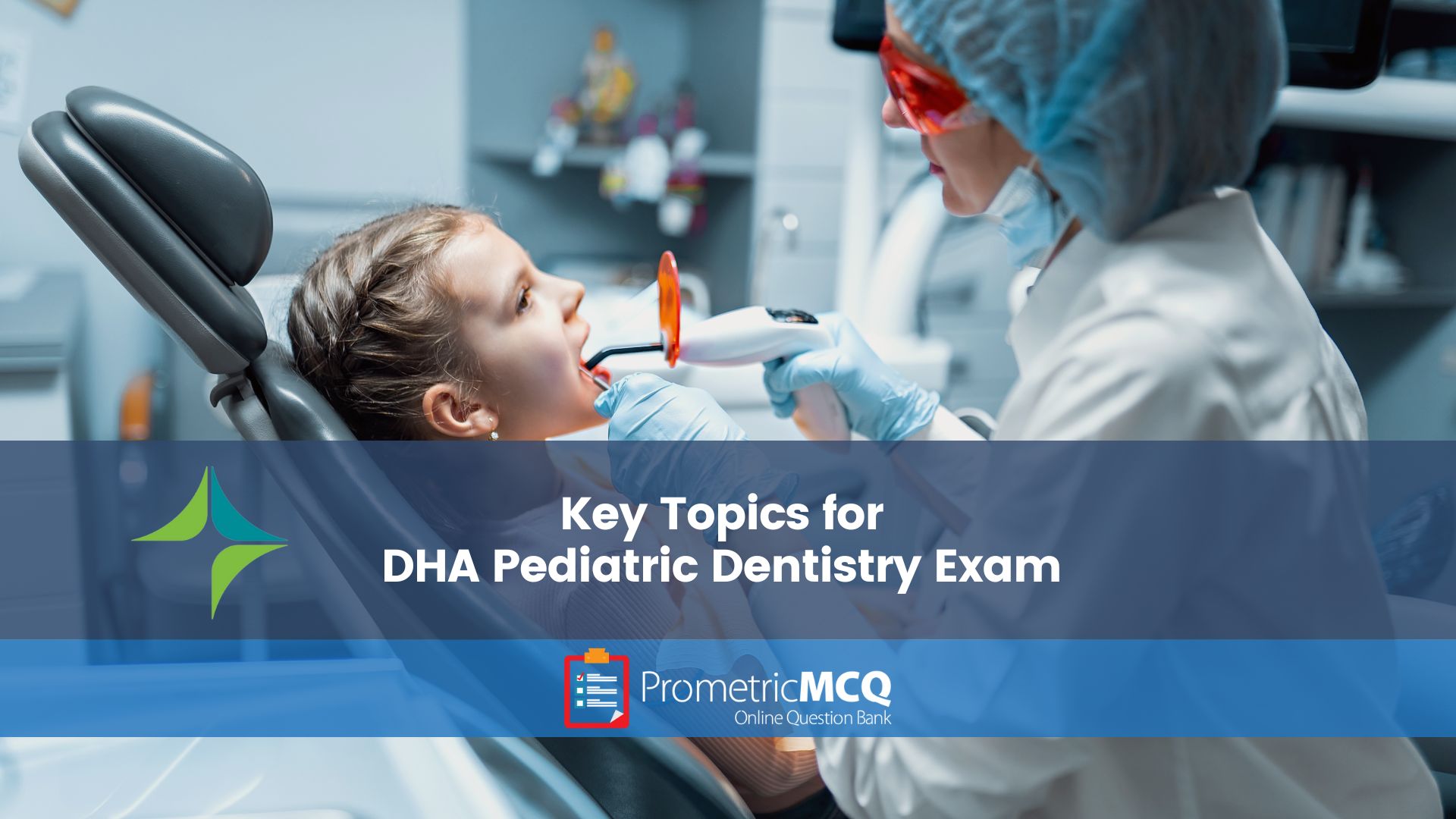
Key Topics for DHA Pediatric Dentistry Exam
Webmaster2024-05-02T11:44:20+00:00Are you ready to excel in the world of pediatric dentistry and conquer the DHA Exam with confidence? Picture this: you’re in the midst of your exam, facing questions on crucial pediatric dentistry topics. How do you ensure you have the knowledge and insight to tackle them effectively and emerge victorious?
Let’s delve into the core focus areas and key topics that the DHA Exam is designed to test in pediatric dentistry. Understanding these essential elements is the cornerstone of your preparation journey. From comprehensive insights into the exam syllabus to strategic tips for navigating the exam pattern, this guide will equip you with the know-how needed to ace the pediatric dentistry section.
Prepare yourself for success by gaining a deep understanding of the pediatric dentistry landscape. With this detailed overview, you’ll be armed with the essential knowledge and resources to confidently tackle the DHA Exam and pave the way for a successful career in pediatric dentistry. Master the key topics, hone your skills, and embrace the journey toward becoming a pediatric dentistry specialist.
Table of Contents
ToggleIntroduction to the DHA Pediatric Dentistry Exam
The Dubai Health Authority (DHA) Exam is a crucial milestone for dental professionals seeking to practice in Dubai. This comprehensive exam evaluates the knowledge and skills of aspiring dentists, ensuring they meet the required standards set by the DHA. Pediatric dentistry plays a significant role in the DHA Exam, as it focuses on the oral health and specialized care of children.
For dentists specializing in pediatric dentistry, excelling in this exam is essential to demonstrate their proficiency in providing dental care to young patients. It is crucial to understand the relevance of pediatric dentistry in the DHA Exam and the significance of ensuring proper oral health for children.
Pediatric dentistry encompasses a broad range of topics, including growth and development, diagnosis and treatment planning, behavior management, preventive dentistry, and more. By mastering these focus areas, dental professionals can effectively address the unique oral health needs of children and provide comprehensive care.
Preparing for the DHA Pediatric Dentistry Exam section of the DHA Exam requires a thorough understanding of the exam syllabus and a comprehensive grasp of the key topics and areas of focus. This guide aims to provide you with the knowledge and resources needed to excel in the pediatric dentistry section of the DHA Exam. Let’s dive into the key components and topics covered in this section to ensure you are well-equipped for success.
Understanding the DHA Pediatric Dentistry Exam Syllabus
The pediatric dentistry section of the DHA Exam is a crucial component for dental professionals seeking licensure in Dubai. To excel in this section, it is essential to have a comprehensive understanding of the key components and topics covered. By familiarizing yourself with the DHA Exam syllabus, you can effectively allocate your time and resources to areas of greater importance.
The pediatric dentistry section of the DHA Exam encompasses several focus areas, each carrying its own weightage and significance. Let’s explore these focus areas in detail:
Focus Area 1: Growth and Development
Understanding the growth and development process is vital in pediatric dentistry. This focus area covers key concepts and milestones related to dental development in children. Familiarize yourself with the stages of tooth eruption, development of occlusion, and dental arch morphology.
Focus Area 2: Etiology of Dental Malocclusion
Dental malocclusion can have a significant impact on oral health. This focus area examines the causes and contributing factors leading to malocclusion in pediatric patients. Gain knowledge about different types of malocclusion, such as class I, class II, and class III, and their implications for treatment planning.
Focus Area 3: Diagnosis and Treatment Planning in Pediatric Dentistry
Accurate diagnosis and effective treatment planning are essential skills in pediatric dentistry. This focus area emphasizes the process of diagnosing dental conditions in children and creating tailored treatment plans. Consider growth and development factors when formulating your treatment strategies.
Focus Area 4: Preventive Dentistry in Pediatric Patients
Preventive measures play a crucial role in pediatric dentistry. This focus area emphasizes the significance of preventive techniques, including fluoride treatment, sealants, and oral hygiene education. Understand the best practices for preventing dental caries and promoting optimal oral health in young patients.
Focus Area 5: Behavior Management in Pediatric Dentistry
Managing the behavior of pediatric patients during dental procedures requires effective communication and rapport-building. This focus area explores strategies for behavior management in children, fostering positive dental experiences and minimizing anxiety.
Remember, each of these focus areas carries a specific weightage and importance in the DHA Exam. Devote sufficient time and effort to comprehensively prepare for each of these topics to maximize your chances of success in this critical examination.
Focus Area 1: Growth and Development
Understanding the growth and development of pediatric patients is crucial in the field of pediatric dentistry. By comprehending the key concepts and milestones related to dental development, dental professionals can provide effective and appropriate oral healthcare.
During the early years, the growth and development of a child’s dentition play a vital role in determining their future oral health. It is important to recognize that dental development is a dynamic process, influenced by genetic, environmental, and behavioral factors. By understanding this process, dental professionals can identify any deviations from the normal pattern and provide timely interventions when necessary.
Key Concepts in Growth and Development:
- Eruption Sequence: Familiarize yourself with the typical eruption sequence of primary and permanent teeth. Knowing when to expect the appearance of each tooth is essential for accurate diagnosis and treatment planning.
- Dental Anomalies: Learn about common dental anomalies such as delayed eruption, anomalies in tooth morphology, and variations in tooth number. These anomalies may impact oral health and require specific management techniques.
- Occlusion: Gain knowledge about occlusal relationships and how they relate to dental development. Understanding normal occlusion patterns and identifying malocclusion early on can help prevent future complications.
- Craniofacial Development: Appreciate the intricate relationship between dental development and craniofacial growth. Changes in the craniofacial complex can influence dental occlusion and oral function.
Milestones in Dental Development:
- Teething: Recognize the signs and symptoms associated with teething and provide appropriate advice to parents on comforting measures and oral hygiene.
- Transition from Primary to Permanent Dentition: Understand the chronological and physiological sequence of the exfoliation of primary teeth and eruption of permanent teeth. This knowledge enables early detection of any abnormalities in dental development.
- Mixed Dentition: Be familiar with the mixed dentition stage, where both primary and permanent teeth coexist. This is a critical period for monitoring occlusal development and addressing any orthodontic concerns.
In summary, a thorough understanding of growth and development in pediatric dentistry is paramount for providing optimal care to young patients. By incorporating this knowledge into clinical practice, dental professionals not only ensure healthy dental development but also contribute to the overall well-being of children.
Focus Area 2: Etiology of Dental Malocclusion
Dental malocclusion refers to the misalignment of the teeth and jaws, which can significantly impact oral health and overall well-being. Understanding the causes and factors contributing to dental malocclusion in pediatric patients is crucial for dental professionals preparing for the DHA Exam. In this section, we will explore the various elements that contribute to this condition and discuss its implications for oral health.
Causes and Factors Contributing to Dental Malocclusion
Dental malocclusion can be caused by a combination of genetic and environmental factors. While genetic predisposition plays a significant role, certain habits and conditions can also contribute to its development. Here are some key causes and factors to consider:
- Genetic Factors: Inherited traits, such as jaw size and tooth positioning, can influence the likelihood of developing malocclusion. A family history of malocclusion increases the risk for pediatric patients.
- Thumb Sucking and Pacifier Use: Prolonged thumb sucking or pacifier habits can lead to misalignment of the teeth and jaws. These actions exert pressure on the developing dental arches, resulting in malocclusion.
- Tongue Thrusting: Incorrect tongue posture, such as pushing the tongue against the front teeth while swallowing or speaking, can contribute to malocclusion over time.
- Mouth Breathing: Breathing through the mouth instead of the nose can affect proper jaw development, leading to malocclusion. Allergies, nasal congestion, or obstructed airways can contribute to mouth breathing.
Common Types of Malocclusion and Their Impact on Oral Health
There are several types of malocclusion that dental professionals should be familiar with. Each type can have unique effects on oral health, including:
- Overbite: When the upper front teeth overlap significantly with the lower front teeth, it is known as an overbite. This condition can lead to difficulty in chewing, speech impairment, and increased risk of trauma to the front teeth.
- Underbite: In contrast to an overbite, an underbite occurs when the lower front teeth protrude beyond the upper front teeth. Underbites can cause difficulties in biting and chewing, as well as potential issues with jaw joint function and facial aesthetics.
- Crossbite: A crossbite refers to the misalignment of the upper and lower dental arches, causing some teeth to sit inside the opposite arch. This condition can result in tooth wear, gum problems, and potential jaw asymmetry.
- Open Bite: An open bite is characterized by a lack of vertical overlap between the front teeth when the back teeth are biting together. It can lead to speech difficulties, problems with chewing certain foods, and increased susceptibility to tooth decay.
Understanding the causes, types, and impact of dental malocclusion will be beneficial for dental professionals preparing for the DHA Exam. By recognizing these factors and their effects on oral health, practitioners will be better equipped to diagnose and provide appropriate treatment for pediatric patients with malocclusion.
Focus Area 3: Diagnosis and Treatment Planning in Pediatric Dentistry
In pediatric dentistry, accurate diagnosis and effective treatment planning are crucial for providing optimal oral healthcare to children. The process involves assessing dental conditions, identifying problems, and developing comprehensive treatment plans that consider the unique needs of young patients. With a focus on promoting oral health and preventing future issues, diagnosis and treatment planning play a significant role in pediatric dental practice.
Importance of Diagnosis in Pediatric Dentistry
Accurate diagnosis forms the foundation of successful treatment in pediatric dentistry. Dentists must carefully evaluate a child’s dental health, considering factors such as age, growth, and development. Observation, radiographic imaging, and other diagnostic tools help identify dental conditions, including caries, malocclusion, and developmental abnormalities. By conducting thorough examinations, dentists can analyze the patient’s oral health, detect potential problems, and determine suitable treatment approaches.
Creating Effective Treatment Plans
After diagnosing dental conditions, dentists can create personalized treatment plans for children. Treatment planning takes into account the specific needs and circumstances of each patient. Dentists consider the child’s age, dental development, and behavioral aspects, tailoring the plan accordingly. Addressing not only current issues but also considering long-term oral health goals is essential in pediatric dentistry.
Incorporating Growth and Development in Treatment Planning
Understanding growth and development is integral when planning treatment for pediatric patients. Dental procedures must align with a child’s growth patterns to achieve optimal outcomes. Dentists evaluate factors such as eruption of teeth, jaw development, and occlusion to determine the timing and effectiveness of interventions. By considering growth and development, dentists can offer proactive treatment that minimizes the need for future invasive procedures.
In conclusion, the diagnosis and treatment planning process in pediatric dentistry is critical for providing effective and comprehensive oral healthcare to children. By accurately diagnosing dental conditions and designing personalized treatment plans, dentists can promote healthy smiles and prevent future oral health problems. Understanding the importance of growth and development in treatment planning ensures that interventions are timed appropriately, maximizing positive outcomes for young patients.
Focus Area 4: Preventive Dentistry in Pediatric Patients
Preventive dentistry plays a crucial role in maintaining the oral health of pediatric patients. By implementing effective preventive measures, dental professionals can help children develop good oral hygiene habits and prevent the onset of dental diseases. In this section, we will explore the significance of preventive dentistry in pediatric care and discuss various techniques that can be employed to ensure optimal oral health.
Importance of Preventive Measures
Preventive dentistry aims to proactively address oral health issues before they become major problems. By focusing on preventive measures, dental professionals can help children avoid dental caries, gum diseases, and other oral health complications. It involves educating both children and their parents about the importance of proper oral hygiene practices and regular dental check-ups.
Techniques in Preventive Dentistry
- Fluoride Treatment: Fluoride is a key component in preventing tooth decay. Dental professionals may recommend fluoride treatments to strengthen the enamel and protect teeth from cavities. These treatments are typically delivered through gels, rinses, or professionally applied varnishes.
- Sealants: Dental sealants are thin protective coatings applied to the biting surfaces of molars. They act as a shield, preventing bacteria and food particles from settling in the crevices and causing decay. Sealants are a highly effective preventive measure for children at risk of developing cavities.
- Oral Hygiene Education: Teaching children the importance of proper brushing and flossing techniques is crucial in preventing oral health issues. Dental professionals should provide age-appropriate oral hygiene education to children and their parents, emphasizing the correct brushing technique, the importance of regular dental visits, and the role of a balanced diet in maintaining oral health.
By incorporating these preventive measures into pediatric dental practice, dental professionals can empower children to take charge of their oral health and promote a lifetime of healthy smiles.
Focus Area 5: Behavior Management in Pediatric Dentistry
Managing the behavior of pediatric patients during dental procedures is crucial for creating a positive and comfortable experience. By employing effective strategies, dental professionals can ensure successful treatment outcomes while maintaining the trust and cooperation of young patients.
Importance of Communication
Clear and open communication plays a pivotal role in behavior management. Dentists should establish a rapport with children by using a friendly and reassuring tone. Explaining procedures in simple language helps alleviate any fears or anxieties they may have. It is essential to involve both the child and their parent or guardian in discussions, ensuring all parties understand the treatment plan and expectations.
Building Trust
Building trust with pediatric patients is vital to establish a foundation of cooperation. Dental professionals should take time to engage with children, allowing them to express their concerns and preferences. Patience, empathy, and understanding are key attributes in fostering a trusting relationship. By acknowledging and addressing their fears, dentists can create a safe and secure environment for treatment.
Distraction Techniques
Utilizing distraction techniques can help redirect a child’s focus away from the dental procedure. Engaging them in conversation about their interests or using visual aids, such as toys or books, can effectively divert their attention. Creating a friendly and welcoming dental environment with colorful decorations and child-friendly amenities also contributes to distraction and relaxation.
Positive Reinforcement
Employing positive reinforcement techniques can motivate and encourage pediatric patients during dental visits. Praising their bravery, cooperation, and tolerance throughout the appointment reinforces positive behaviors. Small rewards, such as stickers or certificates, can further reinforce their accomplishments. By acknowledging their efforts, children are more likely to view dental visits positively and develop a sense of ownership over their oral health.
In conclusion, effective behavior management is essential in pediatric dentistry to ensure successful treatment outcomes and enhance the overall dental experience for young patients. By employing strategies like clear communication, trust-building, distraction techniques, and positive reinforcement, dental professionals can create a nurturing and comfortable atmosphere that fosters cooperation and instills proper oral care habits.
Focus Area 6: Dental Trauma in Pediatric Patients
Dental trauma in pediatric patients is not uncommon and requires prompt attention and appropriate management techniques. Understanding the common scenarios and their management is crucial for dental professionals appearing for the DHA Exam. Here, we will discuss the common dental trauma scenarios in pediatric patients and the importance of prompt treatment and follow-up care.
Common Dental Trauma Scenarios
1. Avulsion of Permanent Teeth: This occurs when a permanent tooth completely comes out of its socket. Immediate care involves handling the tooth by the crown (avoiding touching the root) and replanting it in the socket if possible. The patient should be rushed to a dental professional for further evaluation and stabilization.
2. Fractured Teeth: Different types of fractures can occur, including enamel-only fractures, enamel-dentin fractures, and complicated fractures involving the pulp. Treatment options vary based on the severity and location of the fracture, and dental professionals need to accurately diagnose and provide appropriate interventions.
3. Luxation Injuries: These injuries involve displacement of teeth within the socket, including subluxation (tooth remains in the socket but is slightly loosened), lateral luxation (tooth is pushed sideways), and intrusion (tooth is pushed into the socket). Immediate repositioning and stabilization are necessary to preserve the tooth structure and prevent further complications.
Importance of Prompt Treatment and Follow-Up Care
Prompt treatment of dental trauma in pediatric patients is essential to increase the chances of successful outcomes. Delayed or inadequate care can result in permanent damage or loss of teeth, leading to functional and aesthetic issues. Importantly, follow-up care is necessary to monitor the healing process, ensure proper occlusion, and address any potential complications.
To enhance patient outcomes, dental professionals must stay updated with the latest guidelines and techniques in managing dental trauma in pediatric patients. Keeping abreast of research and attending relevant continuing education programs can further develop their expertise in this focus area.
Remember, dental trauma in pediatric patients is time-sensitive, and timely intervention plays a vital role in achieving optimal treatment outcomes. By understanding the common scenarios and appropriate management techniques, dental professionals can effectively handle such cases and improve their chances of success in the DHA Exam.
Focus Area 7: Pediatric Endodontics
Pediatric endodontics involves specialized dental procedures aimed at treating and preserving the dental health of children. In this focus area, we will explore the unique challenges and considerations that arise when performing endodontic procedures on young patients.
Overview of Pediatric Endodontics
Pediatric endodontics primarily focuses on two key procedures: pulpotomy and pulp therapy. Pulpotomy involves the removal of infected pulp tissue from the crown portion of the tooth, while pulp therapy involves the removal of infected pulp tissue from the entire tooth.
Pulpotomy
Pulpotomy is a common procedure employed in pediatric dentistry to address deep dental caries that extend into the pulp chamber. This procedure aims to preserve the remaining healthy pulp tissue and promote the tooth’s natural healing process. It is typically performed on primary (baby) teeth with extensive decay.
During pulpotomy, the dentist removes the affected pulp tissue, sterilizes the remaining portion, and then applies a medicament to promote healing and prevent further infection. The tooth is then restored with a suitable material to maintain its integrity and function.
Pulp Therapy
Pulp therapy is performed when the infection has spread beyond the pulp chamber into the root canals of the tooth. This procedure involves the complete removal of the infected pulp tissue, including the root canals. After cleaning and disinfecting the canals, a suitable material is placed to fill the void and restore the tooth’s structural integrity.
Challenges in Treating Young Patients
Pediatric endodontics presents unique challenges due to the anatomical differences in primary teeth and the behavioral aspects of young patients. The size and shape of primary teeth can make accessing and treating the pulp chamber and root canals more challenging. Additionally, children may exhibit anxiety and fear during dental procedures, requiring a gentle and supportive approach from the dentist.
Conclusion
Pediatric endodontics plays a crucial role in preserving the dental health of children. Pulpotomy and pulp therapy are effective treatments for deep cavities and infected pulps in primary teeth. Dentists practicing pediatric endodontics must be well-versed in the unique challenges and considerations of treating young patients. By providing comprehensive and gentle care, dental professionals can contribute to the oral health and well-being of children.
Focus Area 8: Caries Risk Assessment and Management in Pediatric Dentistry
Caries, or tooth decay, is a prevalent concern in pediatric dentistry. Assessing and managing caries risk factors in pediatric patients is crucial to prevent dental problems and promote oral health. Here, we will explore the assessment and management of caries risk factors in pediatric dentistry, highlighting the importance of preventive measures and early intervention.
Assessing Caries Risk Factors
To effectively manage caries in pediatric patients, dentists must first assess the risk factors involved. The assessment typically involves evaluating various aspects, including:
- Oral hygiene practices: Assessing the child’s brushing habits, flossing routines, and overall oral hygiene practices.
- Dietary habits: Examining the child’s dietary choices, particularly their consumption of sugary and acidic foods and beverages.
- Previous dental history: Reviewing the child’s past dental treatments, cavities, and restorations.
- Salivary flow and composition: Assessing the quantity and quality of saliva, as saliva plays a crucial role in protecting against tooth decay.
- Socioeconomic factors: Considering socio-economic factors that may impact access to dental care and oral hygiene practices.
Managing Caries Risk
Once the risk factors are identified, appropriate interventions can be implemented to manage caries risk. The management strategies commonly used in pediatric dentistry include:
- Oral hygiene education: Providing comprehensive guidance on proper brushing techniques, flossing, and the use of fluoride toothpaste.
- Dietary counseling: Educating parents and children about the importance of a balanced diet, emphasizing the reduction of sugary and acidic food and drink consumption.
- Fluoride treatment: Administering topical fluoride applications to strengthen tooth enamel and inhibit the progression of caries.
- Sealants: Applying dental sealants to the occlusal surfaces of permanent posterior teeth to provide an additional protective barrier against caries.
- Regular dental visits: Encouraging regular check-ups and professional cleanings to detect caries at an early stage and provide necessary treatments promptly.
- Cavity risk assessment: Conducting periodic caries risk assessments to monitor changes in risk levels and adjust preventive measures accordingly.
By implementing these preventive measures and intervening early, pediatric dentists can effectively manage caries risk in children, promoting healthy smiles and long-term oral health.
Remember, prevention is key when it comes to caries management in pediatric dentistry. Taking a proactive approach and addressing risk factors early on can significantly reduce the incidence and severity of tooth decay in young patients.
Focus Area 9: Special Needs Dentistry
For dental professionals, providing care to children with special needs requires a unique set of considerations and techniques. Effective communication and accommodation are essential components of delivering dental treatments in a manner that ensures the comfort and well-being of these patients.
When treating children with special needs, it is crucial to first understand their individual requirements and medical history. This knowledge helps tailor the dental treatment plan and approach to accommodate their specific needs. Effective communication is key to establishing trust and ensuring cooperation throughout the dental visit.
Strategies for effective communication include using simple language, visual aids, and social stories to help children with special needs understand the dental procedures. Taking the time to build a rapport with these patients can greatly reduce anxiety and make the dental experience more comfortable for them.
Accommodations should be made to create a safe and comfortable environment in the dental office. This includes providing sensory-friendly settings, such as dimmed lighting or calming music, to help alleviate potential sensory overload. Dental professionals should also be knowledgeable about behavior management techniques that can be used to help children with special needs feel more at ease during dental procedures.
Collaboration with other healthcare professionals and caregivers is vital when providing dental care to children with special needs. This interdisciplinary approach ensures comprehensive and coordinated care.
In conclusion, special needs dentistry requires careful consideration of individual requirements, effective communication, and accommodation. By implementing strategies tailored to the specific needs of these patients, dental professionals can provide high-quality care while ensuring a positive dental experience for children with special needs.
Focus Area 10: Pediatric Dental Materials and Techniques (200 words)
Choosing the right dental materials and techniques is crucial when providing dental care to pediatric patients. The unique needs and sensitivities of children require special considerations to ensure optimal oral health outcomes. In this section, we will explore the selection and application of dental materials specifically tailored for pediatric dentistry and highlight the importance of choosing materials that meet the oral health needs of children.
Importance of Choosing Suitable Materials
When it comes to pediatric dental care, selecting appropriate materials plays a significant role in ensuring long-term success and patient satisfaction. Pediatric patients have delicate teeth and gums that require gentle handling and materials that are compatible with their developing dentition. Using materials designed for adults may not be suitable for children, as their oral structures and needs differ.
Tailored Dental Materials for Pediatric Dentistry
- Dental Sealants: Sealants are a popular preventive technique used in pediatric dentistry. These thin, protective coatings are applied to the chewing surfaces of molars to prevent cavities. They create a physical barrier, shielding the tooth surfaces from bacteria and food particles.
- Tooth-Colored Fillings: Composite resin fillings are commonly used in pediatric dentistry due to their aesthetic appeal. These tooth-colored fillings blend seamlessly with the natural teeth, ensuring a pleasing appearance while restoring decayed or damaged teeth.
- Stainless Steel Crowns: In cases where extensive tooth decay or damage is present, stainless steel crowns provide durable protection for primary teeth. These crowns are custom-fitted to cover the entire tooth, safeguarding it from further deterioration.
- Glass Ionomer Cement: This versatile dental material is often used in pediatric dentistry. Glass ionomer cement has fluoride-releasing properties, contributing to the prevention of tooth decay. It is commonly used for fillings, cementing crowns, and sealing root surfaces.
Patient-Focused Techniques
In addition to selecting appropriate materials, pediatric dentists employ techniques that prioritize the comfort and well-being of their young patients. This includes:
- Behavior Management: Building rapport and using behavior management techniques, such as distraction, positive reinforcement, and Tell-Show-Do, to create a relaxed and positive dental experience for children.
- Local Anesthesia: Administering local anesthesia to minimize discomfort during procedures, ensuring a pain-free experience for the child.
- Nitrous Oxide Sedation: Utilizing nitrous oxide (laughing gas) as a safe and effective sedation option for anxious or apprehensive patients.
By combining suitable materials with patient-focused techniques, dental professionals can provide optimal care to pediatric patients, ensuring their oral health needs are met in a gentle and effective manner.
Remember, the selection and application of pediatric dental materials and techniques should always be done under the guidance of a qualified and experienced pediatric dentist to ensure the best outcomes for young patients.
Conclusion
In conclusion, preparing for the pediatric dentistry section of the DHA Exam requires a comprehensive understanding of the key focus areas and topics. Thorough preparation and familiarity with these areas are crucial for success in the exam and for becoming a competent dental professional in the field of pediatric dentistry.
To recap, the focus areas and topics covered in the pediatric dentistry section of the DHA Exam include:
- Growth and Development: Understanding the milestones and concepts related to dental development in children is essential.
- Etiology of Dental Malocclusion: Exploring the causes and factors contributing to dental malocclusion in pediatric patients is important for diagnosis and treatment.
- Diagnosis and Treatment Planning: The process of diagnosing dental conditions in children and creating effective treatment plans, considering growth and development, is crucial.
- Preventive Dentistry: Emphasizing preventive measures such as fluoride treatment, sealants, and oral hygiene education is important for maintaining good oral health in pediatric patients.
- Behavior Management: Employing effective strategies to manage the behavior of young patients during dental procedures is vital.
- Dental Trauma: Knowing how to handle dental trauma scenarios in pediatric patients promptly and appropriately is essential.
- Pediatric Endodontics: Understanding endodontic procedures in children, including pulpotomy and pulp therapy, is necessary.
- Caries Risk Assessment and Management: Assessing and managing caries risk factors in pediatric patients is important for early intervention and prevention.
- Special Needs Dentistry: Providing dental care to children with special needs requires knowledge, effective communication, and accommodation.
- Pediatric Dental Materials and Techniques: Choosing and applying dental materials suitable for children’s oral health needs is crucial.
To excel in the DHA Exam, aspiring dental professionals must devote adequate time and resources to understand these focus areas and topics thoroughly. By doing so, they will be better equipped to provide high-quality dental care to pediatric patients and succeed in their careers.
Apply for DHA License - Get Prepared for Exam
Subscribe for DHA Exam Preparation and Apply Licensing Services










